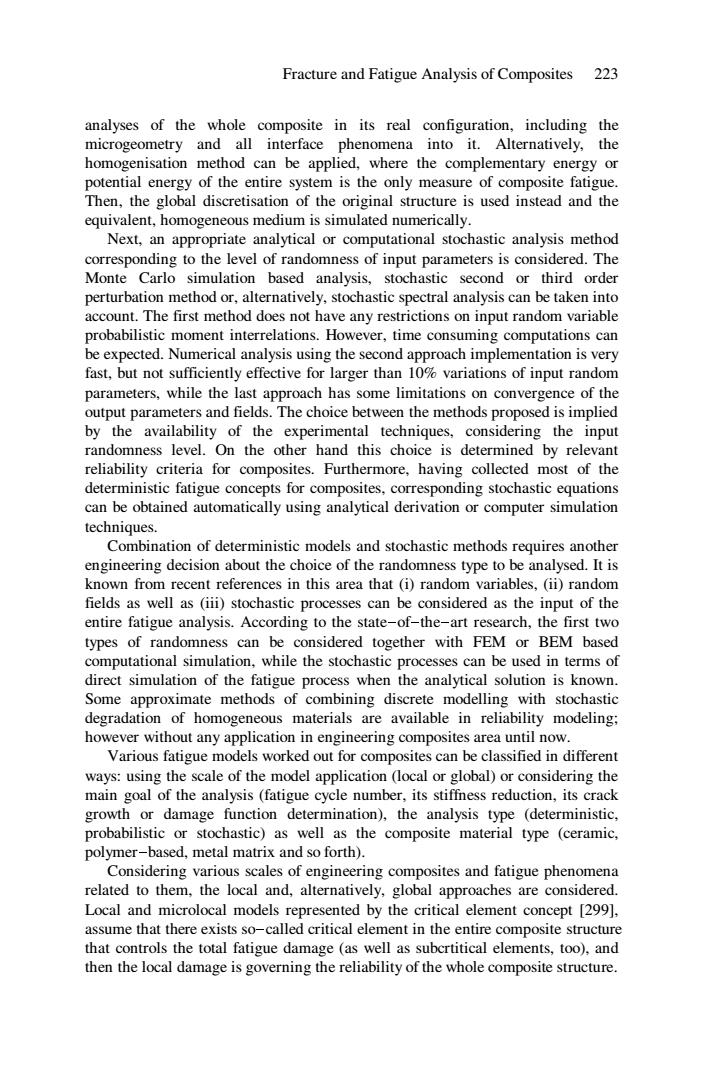正在加载图片...

Fracture and Fatigue Analysis of Composites 223 analyses of the whole composite in its real configuration,including the microgeometry and all interface phenomena into it.Alternatively,the homogenisation method can be applied,where the complementary energy or potential energy of the entire system is the only measure of composite fatigue. Then,the global discretisation of the original structure is used instead and the equivalent,homogeneous medium is simulated numerically. Next,an appropriate analytical or computational stochastic analysis method corresponding to the level of randomness of input parameters is considered.The Monte Carlo simulation based analysis,stochastic second or third order perturbation method or,alternatively,stochastic spectral analysis can be taken into account.The first method does not have any restrictions on input random variable probabilistic moment interrelations.However,time consuming computations can be expected.Numerical analysis using the second approach implementation is very fast,but not sufficiently effective for larger than 10%variations of input random parameters,while the last approach has some limitations on convergence of the output parameters and fields.The choice between the methods proposed is implied by the availability of the experimental techniques,considering the input randomness level.On the other hand this choice is determined by relevant reliability criteria for composites.Furthermore,having collected most of the deterministic fatigue concepts for composites,corresponding stochastic equations can be obtained automatically using analytical derivation or computer simulation techniques. Combination of deterministic models and stochastic methods requires another engineering decision about the choice of the randomness type to be analysed.It is known from recent references in this area that (i)random variables,(ii)random fields as well as (iii)stochastic processes can be considered as the input of the entire fatigue analysis.According to the state-of-the-art research,the first two types of randomness can be considered together with FEM or BEM based computational simulation,while the stochastic processes can be used in terms of direct simulation of the fatigue process when the analytical solution is known. Some approximate methods of combining discrete modelling with stochastic degradation of homogeneous materials are available in reliability modeling; however without any application in engineering composites area until now. Various fatigue models worked out for composites can be classified in different ways:using the scale of the model application (local or global)or considering the main goal of the analysis (fatigue cycle number,its stiffness reduction,its crack growth or damage function determination),the analysis type (deterministic, probabilistic or stochastic)as well as the composite material type (ceramic, polymer-based,metal matrix and so forth). Considering various scales of engineering composites and fatigue phenomena related to them,the local and,alternatively,global approaches are considered. Local and microlocal models represented by the critical element concept [299], assume that there exists so-called critical element in the entire composite structure that controls the total fatigue damage (as well as subcrtitical elements,too),and then the local damage is governing the reliability of the whole composite structure.Fracture and Fatigue Analysis of Composites 223 analyses of the whole composite in its real configuration, including the microgeometry and all interface phenomena into it. Alternatively, the homogenisation method can be applied, where the complementary energy or potential energy of the entire system is the only measure of composite fatigue. Then, the global discretisation of the original structure is used instead and the equivalent, homogeneous medium is simulated numerically. Next, an appropriate analytical or computational stochastic analysis method corresponding to the level of randomness of input parameters is considered. The Monte Carlo simulation based analysis, stochastic second or third order perturbation method or, alternatively, stochastic spectral analysis can be taken into account. The first method does not have any restrictions on input random variable probabilistic moment interrelations. However, time consuming computations can be expected. Numerical analysis using the second approach implementation is very fast, but not sufficiently effective for larger than 10% variations of input random parameters, while the last approach has some limitations on convergence of the output parameters and fields. The choice between the methods proposed is implied by the availability of the experimental techniques, considering the input randomness level. On the other hand this choice is determined by relevant reliability criteria for composites. Furthermore, having collected most of the deterministic fatigue concepts for composites, corresponding stochastic equations can be obtained automatically using analytical derivation or computer simulation techniques. Combination of deterministic models and stochastic methods requires another engineering decision about the choice of the randomness type to be analysed. It is known from recent references in this area that (i) random variables, (ii) random fields as well as (iii) stochastic processes can be considered as the input of the entire fatigue analysis. According to the state-of-the-art research, the first two types of randomness can be considered together with FEM or BEM based computational simulation, while the stochastic processes can be used in terms of direct simulation of the fatigue process when the analytical solution is known. Some approximate methods of combining discrete modelling with stochastic degradation of homogeneous materials are available in reliability modeling; however without any application in engineering composites area until now. Various fatigue models worked out for composites can be classified in different ways: using the scale of the model application (local or global) or considering the main goal of the analysis (fatigue cycle number, its stiffness reduction, its crack growth or damage function determination), the analysis type (deterministic, probabilistic or stochastic) as well as the composite material type (ceramic, polymer-based, metal matrix and so forth). Considering various scales of engineering composites and fatigue phenomena related to them, the local and, alternatively, global approaches are considered. Local and microlocal models represented by the critical element concept [299], assume that there exists so-called critical element in the entire composite structure that controls the total fatigue damage (as well as subcrtitical elements, too), and then the local damage is governing the reliability of the whole composite structure